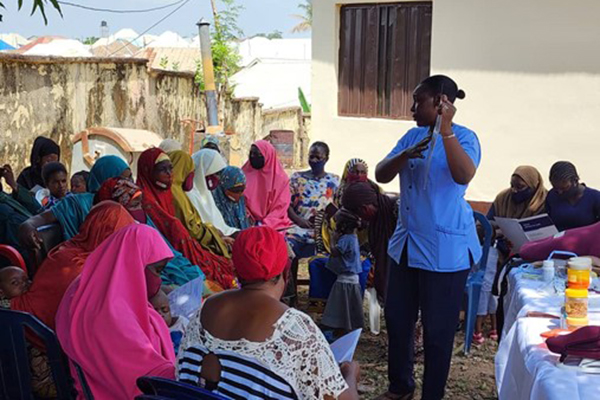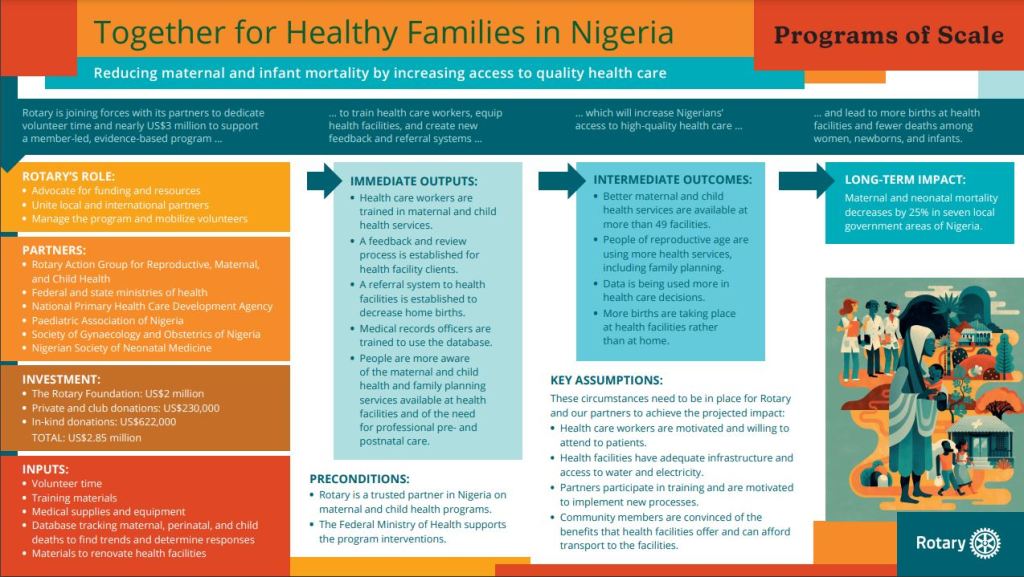
By Rotary International staff
You may have heard the term “theory of change” but not really known what it is. You may have even dismissed it as academic jargon.
But a theory of change is an important part of our Programs of Scale grant process because a well-thought-out theory of change can serve as an indispensable road map to successfully reaching a project’s long-term goal.
And since our Programs of Scale are all about large-scale, big impact, measurable results, a theory of change is an essential thing to develop.
There are many ways to illustrate a theory of change. But perhaps the easiest is to think of a theory of change as an explanation of how a program will achieve its intended impact and in what circumstances.
Let’s break that down further.
Putting it in practice
Think of “change” as the long-term impact you want to make in a community. Take as an example the 2022 Programs of Scale award recipient, Together for Healthy Families in Nigeria, which is aiming to reduce maternal and neonatal mortality rates by improving health seeking behavior and quality care for pregnant women, mothers, and newborns in Nigeria. For this program, the “change” is reducing maternal and neonatal mortality.
The “theory” part is meant to convey that you have a reason for taking the actions you are proposing to reach the change you want. In other words, you believe that certain actions (or outputs), given certain conditions (preconditions and key assumptions), will lead to outcomes that will ultimately contribute to the long-term goal – in this example, reducing maternal and neonatal mortality in Nigeria.

Here is what it looks like in our Nigeria example. Evidence from the World Health Organization shows that giving birth at a health facility rather than at home, can reduce maternal and neonatal deaths in Nigeria. Thus, an outcome for this program is to have more births at health facilities rather than at home.
You may see that and think: we must build more health facilities! However, Rotary members in Nigeria know that building and equipping a new health facility alone will not lead to a reduction in maternal mortality. Why? They know that the clinic staff would have to be trained how to use the equipment – and pregnant women and their families would have to want to travel to and receive services at the clinic. If pregnant women are unable or unwilling to access the clinic, the quality of the staff and equipment at the clinic will not matter.
This is why many of the program actions are geared toward something different than building more facilities. Instead, they are intended to change behavior. These actions include improving the quality of care available at the health facilities, creating a referral system to encourage families to visit them, and increasing awareness of the maternal and child health services available at the facilities.
Actions lead to outcomes
One way the program raises that awareness is through meetings with traditional leaders to encourage them to think of safe childbirth as a community responsibility. Another is training health workers to get them to recognize when it’s necessary to refer women to health facilities for treatment.
In one of the program communities, Alhaji Ayuba Barau, a traditional leader involved in the program, holds regular community dialogue meetings with the men in the community to encourage them to not only contribute money for pre-natal services, but to accompany the mother for antenatal classes offered at the nearest health facilities. Additionally, traditional leaders work with health facilities to ensure quality services are provided. The attitudes in this community are shifting and there has been a gradual increase in families seeking care from health facilities.
A theory of change is not static. The Nigeria program began implementation in early 2023 and this program is continually monitored. If the outcome of more births at health facilities is not realized, the program team will revisit its interventions to understand how to modify it to be on track to see the overall impact.
Drafting a theory of change can be a great exercise and a tool to help your club or district achieve success in your next Rotary project.
Here are some resources to help you get started:
- Learn more about how to develop a theory of change in the Rotary Increase Your Impact Learning Center series
- Together for Healthy Families Theory of Change
- Together for Healthy Families video
https://blog.rotary.org/2023/07/11/what-is-a-theory-of-change/
